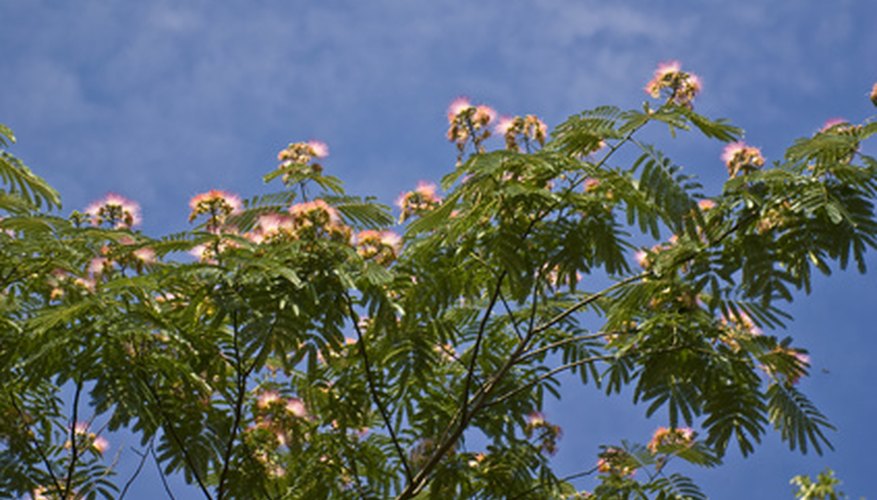A mimosa tree is best known for its unique pink blooms, and is most often used as an ornamental tree. It is popular because of its visual interest and because it attracts butterflies. Mimosa trees are highly invasive in regions of the United States with warm, dry climates. The tree does not tolerate frost well, so precautions should be taken to avoid damage in parts of the country where frosts and freezes occur.
Geography
Mimosa trees are native to Asia and Africa, and prefer regions where the climate is warm and dry. The mimosa was brought to the United States in the 18th century, and it thrives best in U.S. Department of Agriculture hardiness zones six through 10. Those zones cover regions throughout the central U.S. to the southern tip, and coastal areas except the Northeast. Anyone planting a mimosa tree should first consider the climate and the danger of frost damage.
- Mimosa trees are native to Asia and Africa, and prefer regions where the climate is warm and dry.
Prevention
The best way to deal with frost and freeze damage on a mimosa tree is to prevent it from occurring in the first place. Pay attention to frost and freeze advisories, especially during times of the year when temperatures can drop quickly. If a frost or freeze is forecast, the easiest preventive measure is to cover the mimosa tree, if possible. Some trees might be too large to cover, but smaller trees are at the most risk, and can be covered easily with plastic dust sheets, tarps or blankets.
- The best way to deal with frost and freeze damage on a mimosa tree is to prevent it from occurring in the first place.
- If a frost or freeze is forecast, the easiest preventive measure is to cover the mimosa tree, if possible.
Another option is to use traditional incandescent holiday twinkle lights. Wrap the lights around the tree and its branches. While the lights are lit, they emit enough heat to keep a light frost from damaging the mimosa tree.
Shading the mimosa tree from the morning sun will help avoid the burn of frost damage. Dew in the form of frost causes damage by evaporating too quickly, damaging, or "burning" the leaves and blooms when they are struck by the morning sun.
Types of Damage
A light freeze may result in minor frost damage to the outermost layer of leaves and flowers. A hard freeze can result in damage to the leaves and flowers, but also to the branches. If a mimosa has been overexposed to freezing temperatures, it may not continue to grow at all. You will be able to tell the extent of the damage after a few weeks, at which point you will be able to see which portions of the tree are experiencing new growth and which are not.
- A light freeze may result in minor frost damage to the outermost layer of leaves and flowers.
Solutions
If the frost and freeze damaged only some leaves on the tree, you should prune the leaves only after the threat of more frost has passed. Newly pruned areas are particularly susceptible to damage, and the already-damaged leaves can provide temporary protection.
- If the frost and freeze damaged only some leaves on the tree, you should prune the leaves only after the threat of more frost has passed.
For more extensive damage, you should wait two to three weeks after the frost, then observe the tree for new growth. The parts of the tree that are not experiencing new growth should be pruned so the new growth can thrive.
Irreparable Damage
If a mimosa tree experiences freezing temperatures without a thaw period for a week or more, it may experience irreparable damage. This type of freeze damages the tree's tissues and ice crystals grow within the plant cells, rupturing them and killing the tree. This type of damaged tree will not experience new growth and should be removed completely.
